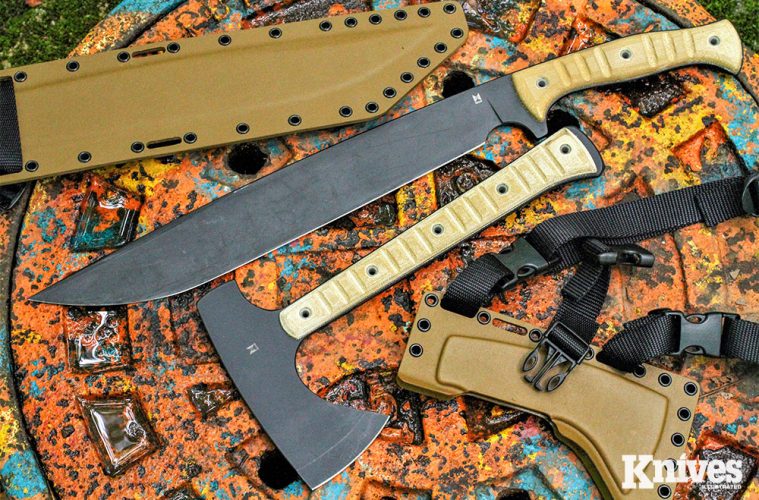JAMES HELM DOESN’T SPARE THE STEEL WHEN IT COMES TO THESE ROBUST CHOPPERS
“Forged in Fire” Champion James Helm is best known for his rustic “tribal looking” forged blades that have an epic appearance. He forges machetes, tomahawks, knives, swords, axes, and a massive carcass splitter. James is no one-trick pony. Not only is he a master of pounding out tools, but he also offers stock removal works of art.
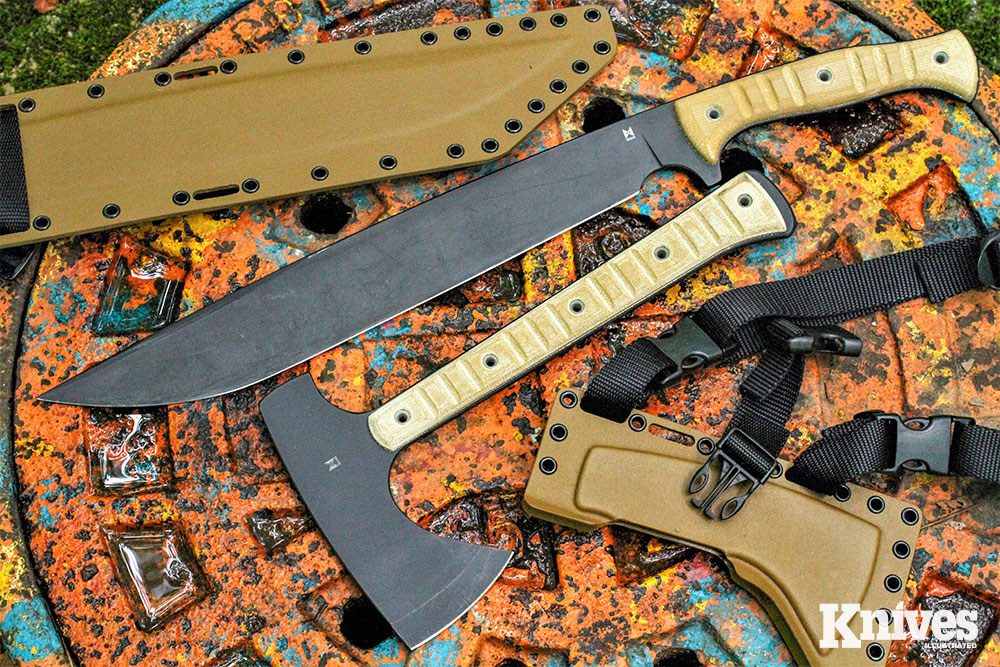
These two formidable choppers from James Helm—the Helm Bush Sword and Woodsman Tomahawk—can hack all your wood’s needs. Both are made with 80CrV2 steel, Coyote Tan TeroTuf scales, and Cerakote coating. Helm Forge Grinding Division makes choppers for all.
Grinding Division
Understanding the man who is James Helm is to first understand the forging side. James loves forging and prefers it over grinding, but it is a slower process. Helm Enterprises, Forging Division is just that. His focus has been on forging cutting tools, and he now will be turning part of his attention to stock removal, grinding hand tools.
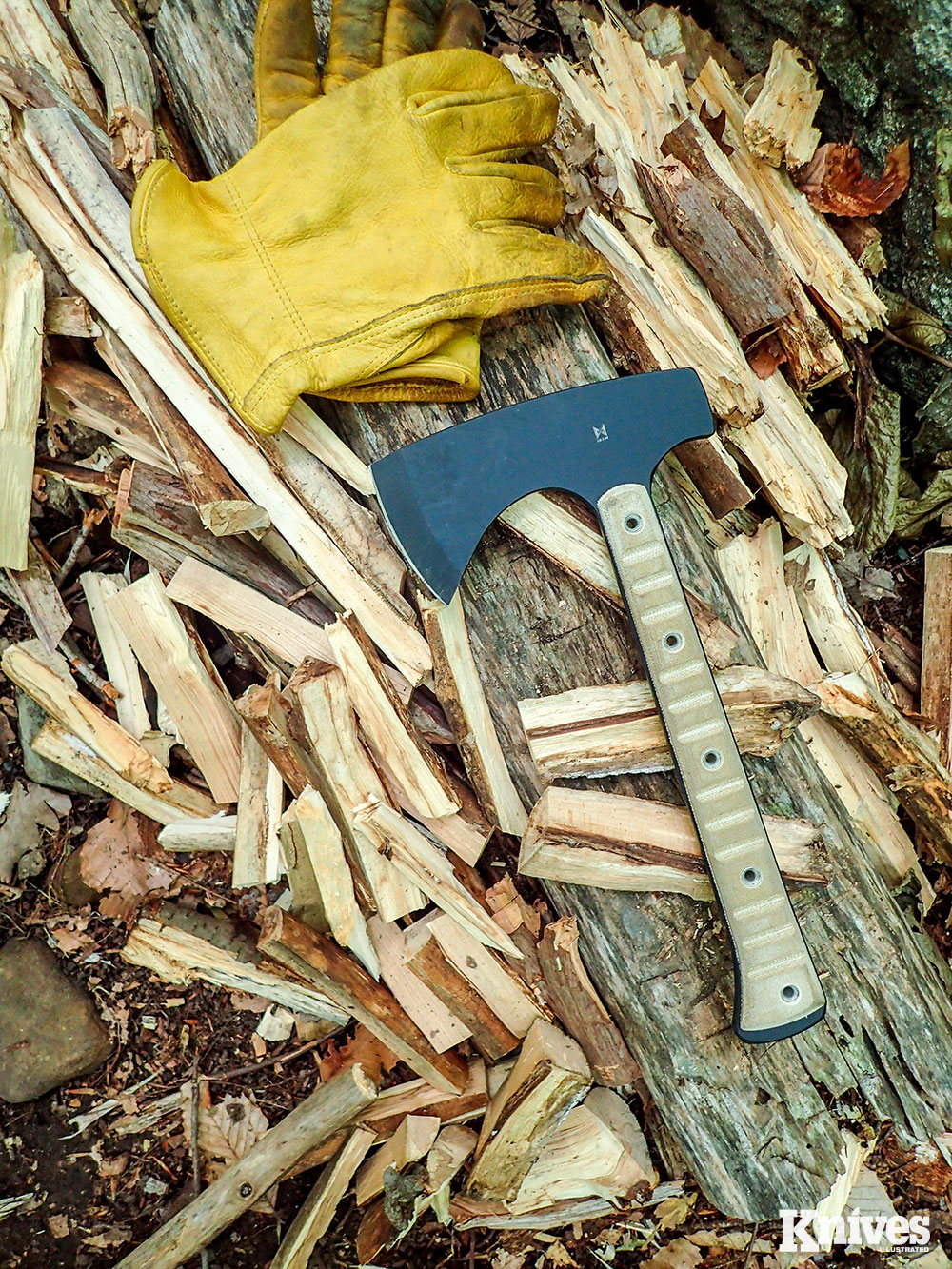
The Woodsman excels at splitting small rounds for wood stoves and campfires. Traditional chop splitting and batoning made this pile of fuel/kindling in no time.
The primary goal of Helm Enterprises, Grinding Division is to build quality blades with military and first responder end-users in mind. The second goal of Helm Enterprises, Grinding Division is to allow James to work more efficiently, producing more blades while keeping prices reasonable. The third goal is to never compromise on quality.
“Mid-tech is a bit of a flexible term,” Helm said. “Mine are ground with muscle control from waterjet-cut blanks, but will have the bevels CNC machined. These will not be fancy pieces; they are working tools.”
HELM HAWKS
James makes three basic tomahawk designs, each available in different lengths and two different color schemes. There is the Woodsman (hammer poll), and Wrecker (pry spike), and a Throwing Hawk.
Aside from utilitarian tasks, the Woodsman’s hammer poll makes a great impact weapon, and the slight hook on the bottom of the poll helps during any potential close-quarter combat in catching and re-directing limbs, according to James.
“The Woodsman Tomahawk proved to be a handy, tough, reliable woods companion in my summer camp.”
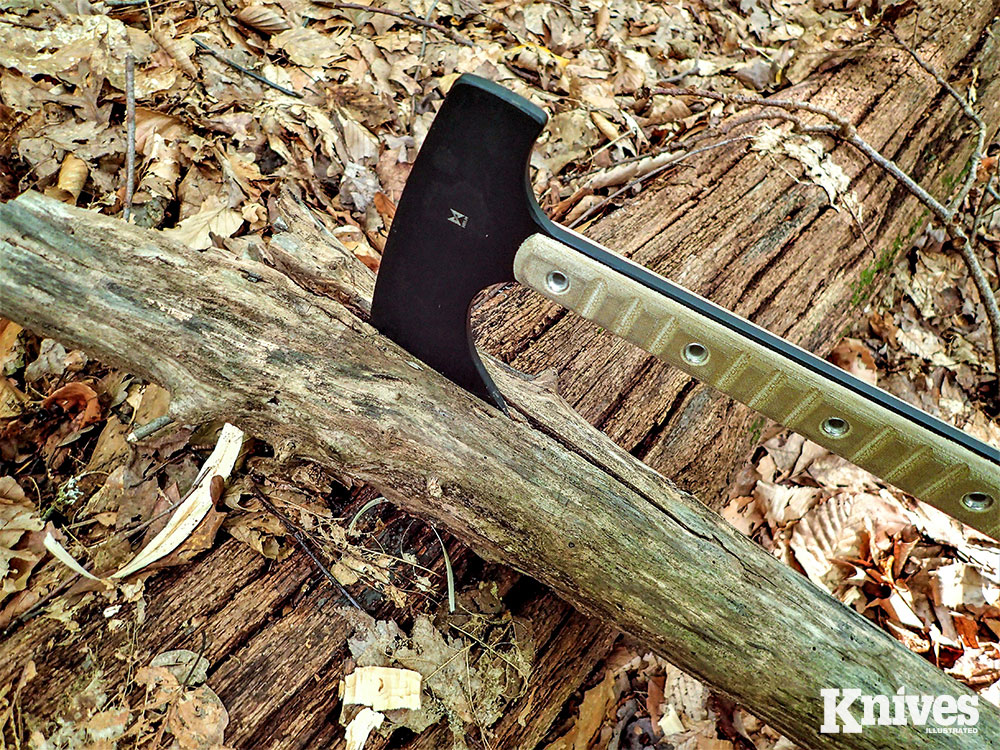
The author used the contact splitting method for longer pieces of wood that didn’t have evenly sawed ends to stand on. This method is also safer for smaller diameter wood.
The butt of the tang is exposed, giving an extra hammering surface and protecting the end of the TeroTuf handle scales from damage. The handle widens as it approaches the end and has a has a swell in its width to aid in retention in the hand while swinging. Throwing tomahawks have handles that are the opposite, tapering to the end to easily slip out of the hand when thrown.
The steel of the Woodsman tomahawk is ¼-inch thick 80CrV2, an alloy James has used extensively for his other blades for several years now. The overall length is 12 ½ inches. The cutting edge is 3 inches long. From the blade to hammer poll is 6 inches across. The coating on the steel is Cerakote ceramic firearm coating. While protective, it will wear during usage.
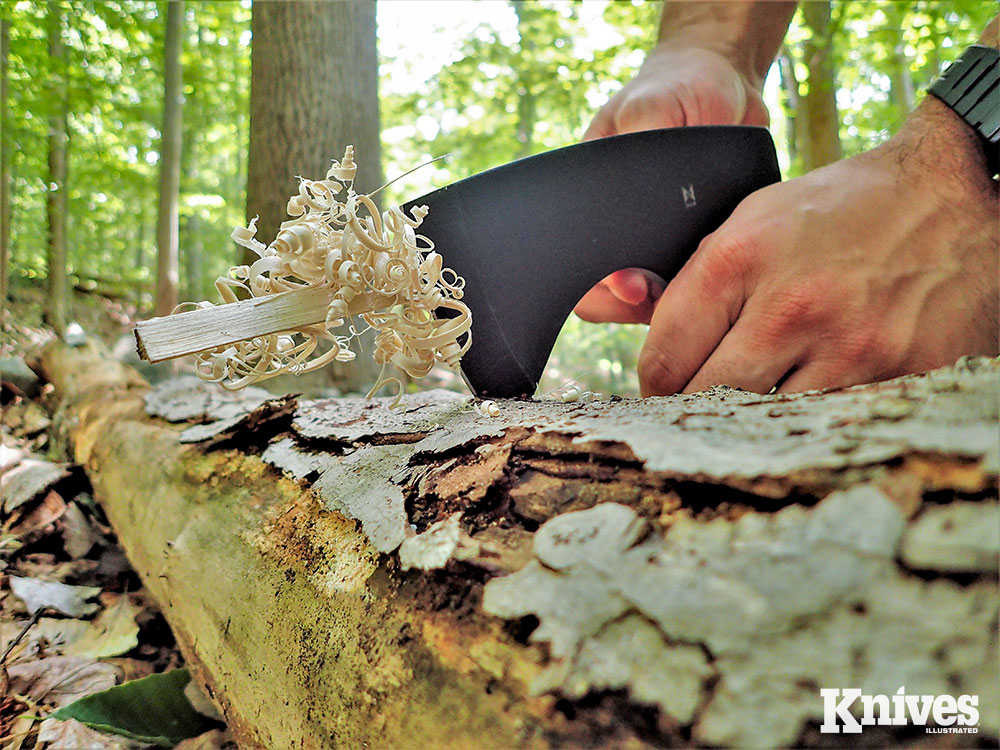
The author uses the Woodsman to make fine fuzz sticks by planting the heel of the tool in a log and drawing wood back against the sharp edge. This is a very safe and efficient way to carve or make thin shavings.
The handle slabs are light Coyote Tan-colored ¼-inch thick TeroTuf, a composite material made of resin-impregnated layers of cloth. It’s very durable, lightweight, grippy, and impervious to most chemicals. The slabs are attached with flared stainless steel tube rivets, which are extremely strong and allow attachment points for lanyards, cord wraps, etc.
Either of the tomahawk designs can be ordered with the inner beard sharpened or unsharpened. This adds to its fighting effectiveness, especially when hooking extremities. However, it can make it a little more dangerous to handle and certainly adds to the aggressive look. The tomahawks can be had in either black or desert tan color schemes.
The sheaths are bottom-ejecting, ambidextrous, with multiple carry options. They are molded from Boltaron, a material similar to Kydex but less vulnerable to temperature extremes. It is common with professional pistol holster makers. Sheaths come standard with a single retention strap.
HEAVY METAL
The Helm Bush Sword has gone through quite a few versions over the years. Originally it was hand-forged out of 5160 spring steel. James wanted to make a stock removal version of this big knife on a quicker, more produced scale for people.
When I first received the package from James Helm, I remember it being one of the largest packages I ever received, with what was quite possibly the largest blade in it. With an overall length of 22 inches, it’s a monster. The Bush Sword has a blade length of 15 1/8 inches, approximately 14 inches of that devoted to the cutting edge.
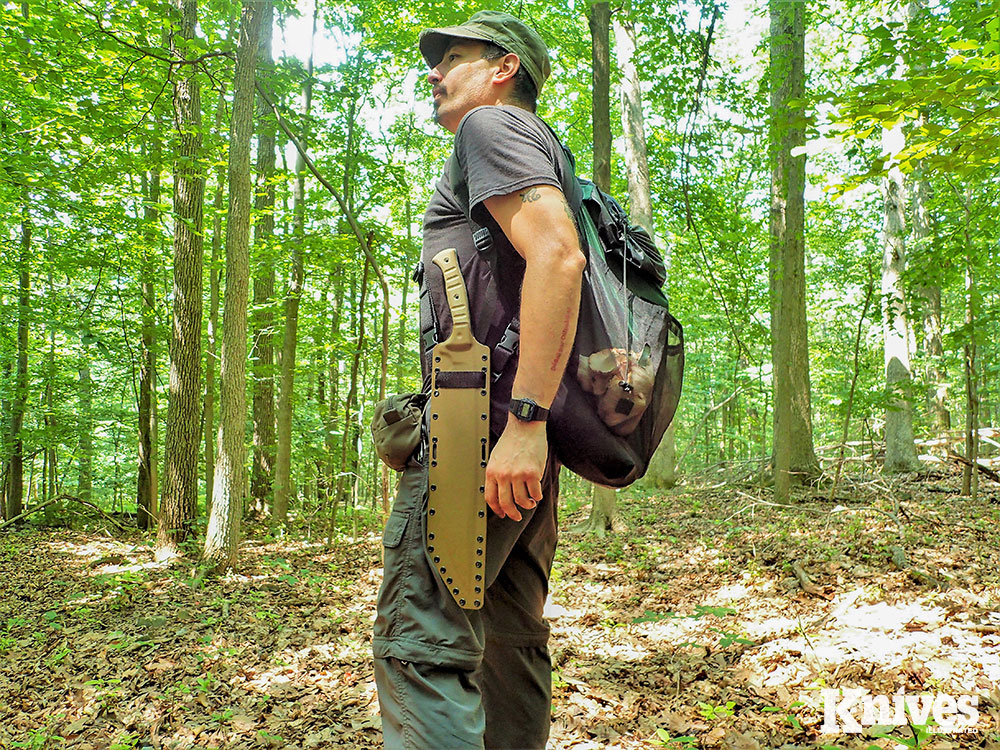
The author preferred to wear the sling over his backpack so the nylon straps rested on top of his pack shoulder straps for more comfort. This made it easier to take on and off as well.
Sticking with large proportions, the handle has 7 inches of useable real estate. Like the Woodsman Tomahawk, the Bush Sword is made from 80CrV2 steel, but 3/16-inch thick and coated with black Cerakote. The monster chopper also has ¼-inch thick TeroTuf scales in Coyote Tan, which offer lots of grip and texture.
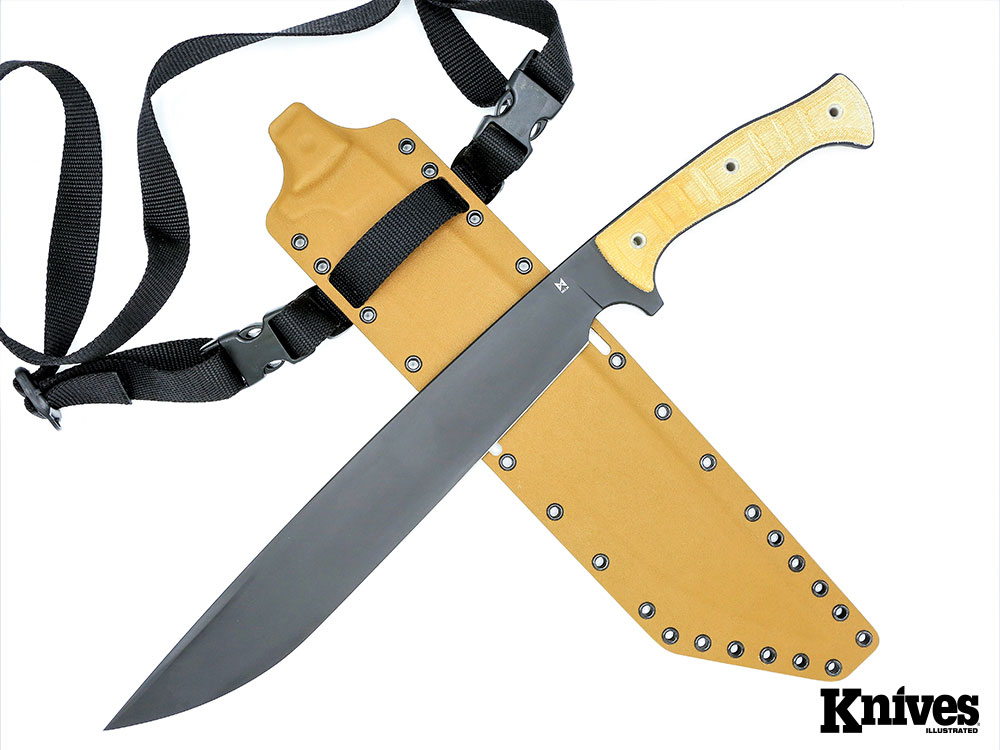
: Helm Bush Sword with an overall length of 22 inches, made from 80CrV2 steel, with Cerakote coating, and TeroTuf scales in Coyote Tan. A Boltaron sheath is standard with an optional shoulder strap seen here.
A large blade, like the Bush Sword, requires a large sheath as well. Don’t think this one will have a dangler or even a belt loop. It’s just too long for woods carry—sword fighting maybe. This sheath is a molded Boltaron, over-the-shoulder sling-style sheath. The removable nylon straps can be adjusted as well as be eliminated. Removing the straps is an alternative if the Bush Sword will just be stashed (like a slip sheath) in the pack, or tossed in a vehicle or canoe for transportation.
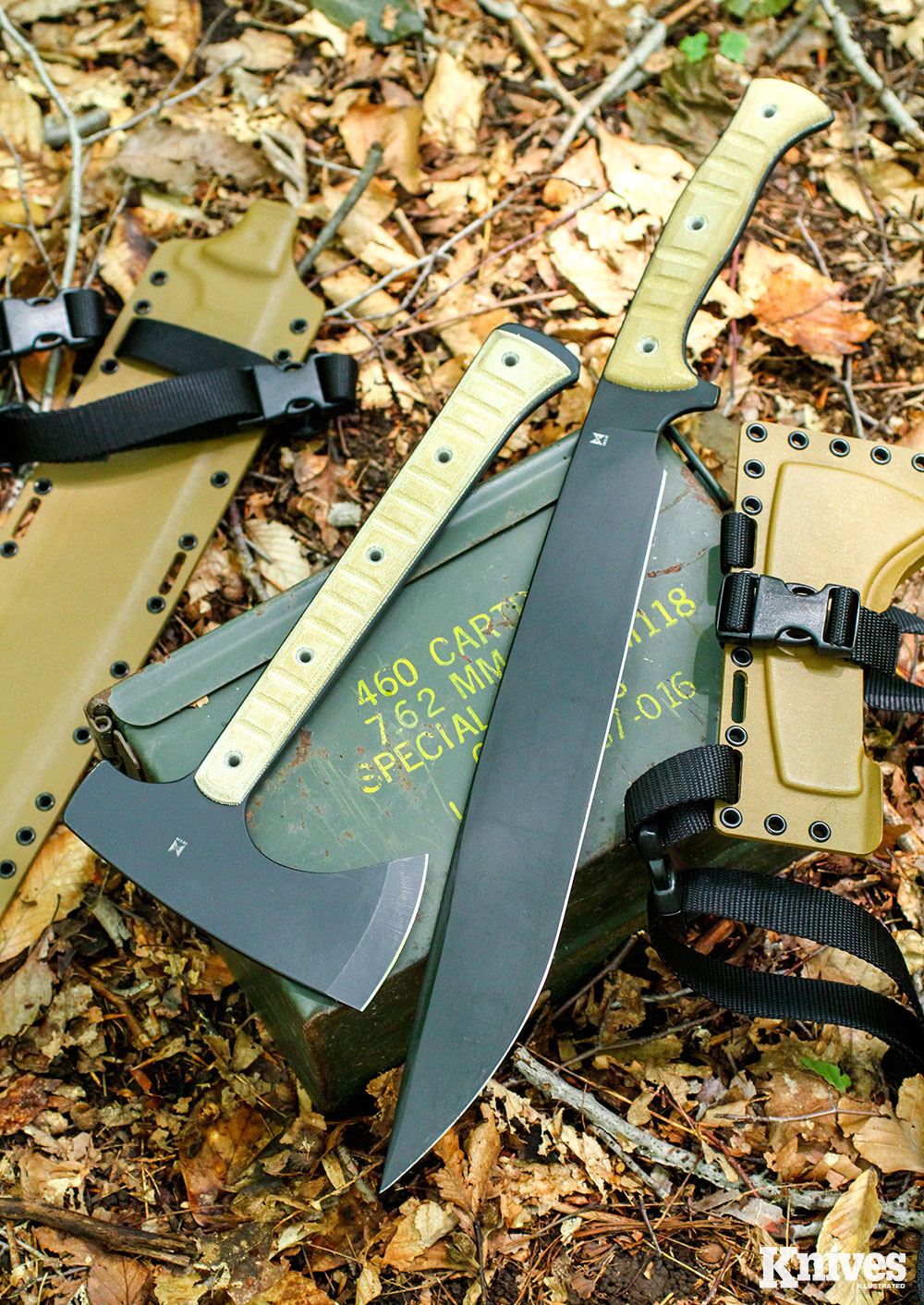
Meant for a hard day’s work, the Helm Woodsman Tomahawk and Bush Sword can be teamed up with other tools or work as a dynamic duo.
DIRT TIME
I chose to evaluate these two wood cutting machines separately as opposed to a combo. Although they may complement each other in some cases, I just feel they do better teamed up with other tools. This is mainly because they do some of the same things like chop and split, just in a different way.
I feel a saw and a small tomahawk work well together, especially when clean flat ends are needed for a project on one end while the other end is carved or notched. A good example of that is making wooden wedges to split larger pieces of wood. I am a fan of using a tool to make other tools, and the Helm Woodsman Tomahawk does just that.
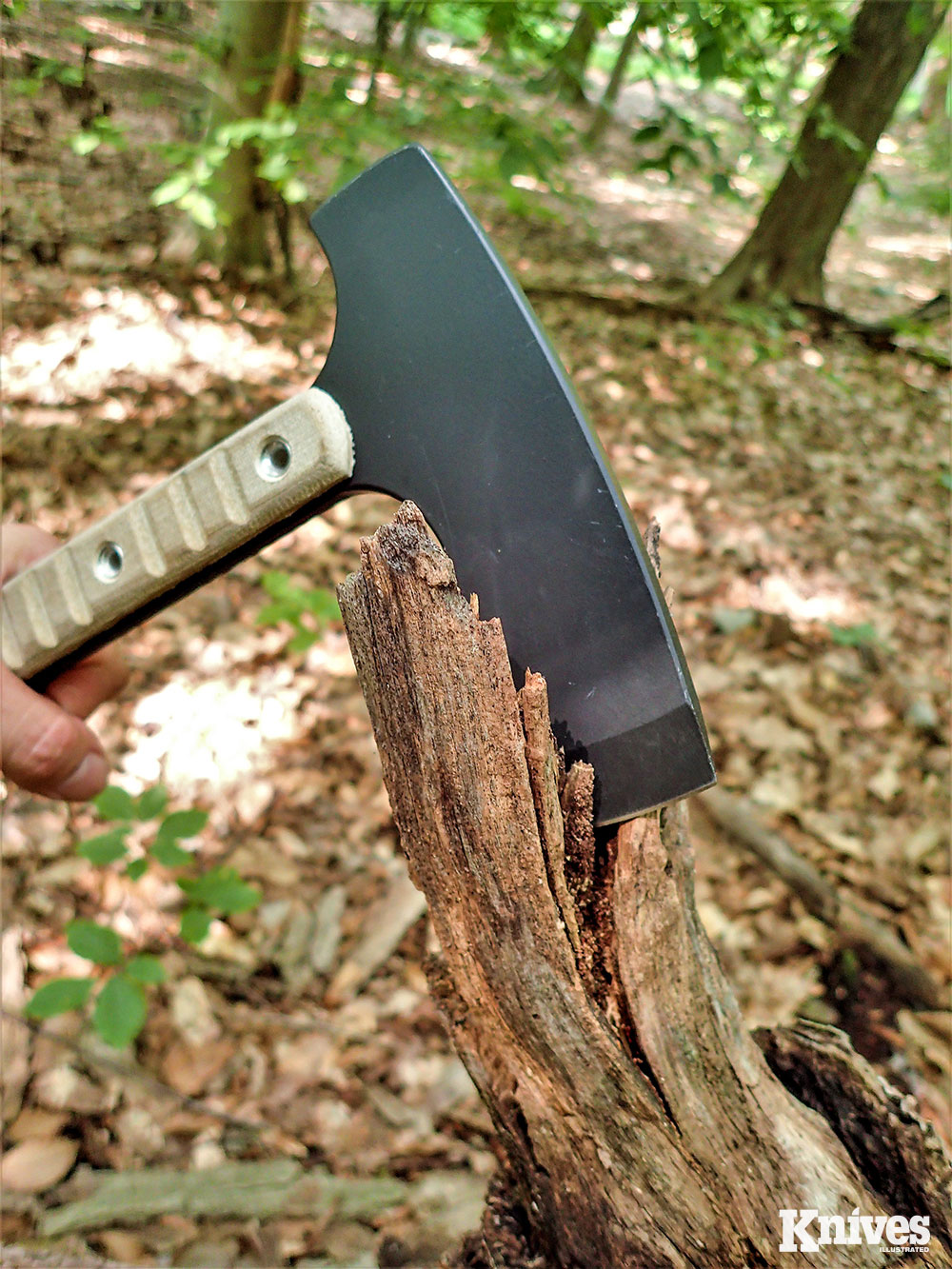
The Woodsman chopped into a piece of oak to chunk off pieces for the small woodstove. This type of prying is perfect for a hardworking tool like the Woodsman.
With a 20-inch bucksaw, I cut several lengths of hardwood and used the Woodsman to carve a chisel end. This usually means short controlled chops with some finer, finishing work at the ends. For this type of work, I gripped the Woodsman closer to the head for control while delivering medium-light chops, tapering the wedge towards the end.
When the desired wedge shape was done I stuck the heel of the Woodsman in the wooden stump and drew the chisel end back against the blade to carve and fine-tune the wedge.
Then, I turned the wedge over and chamfered the straighter saw-cut end for pounding with a baton or hammer poll into the wood. I repeated this process with different lengths of wood thicknesses until I had a decent set of five wedges—a tool that makes tools.
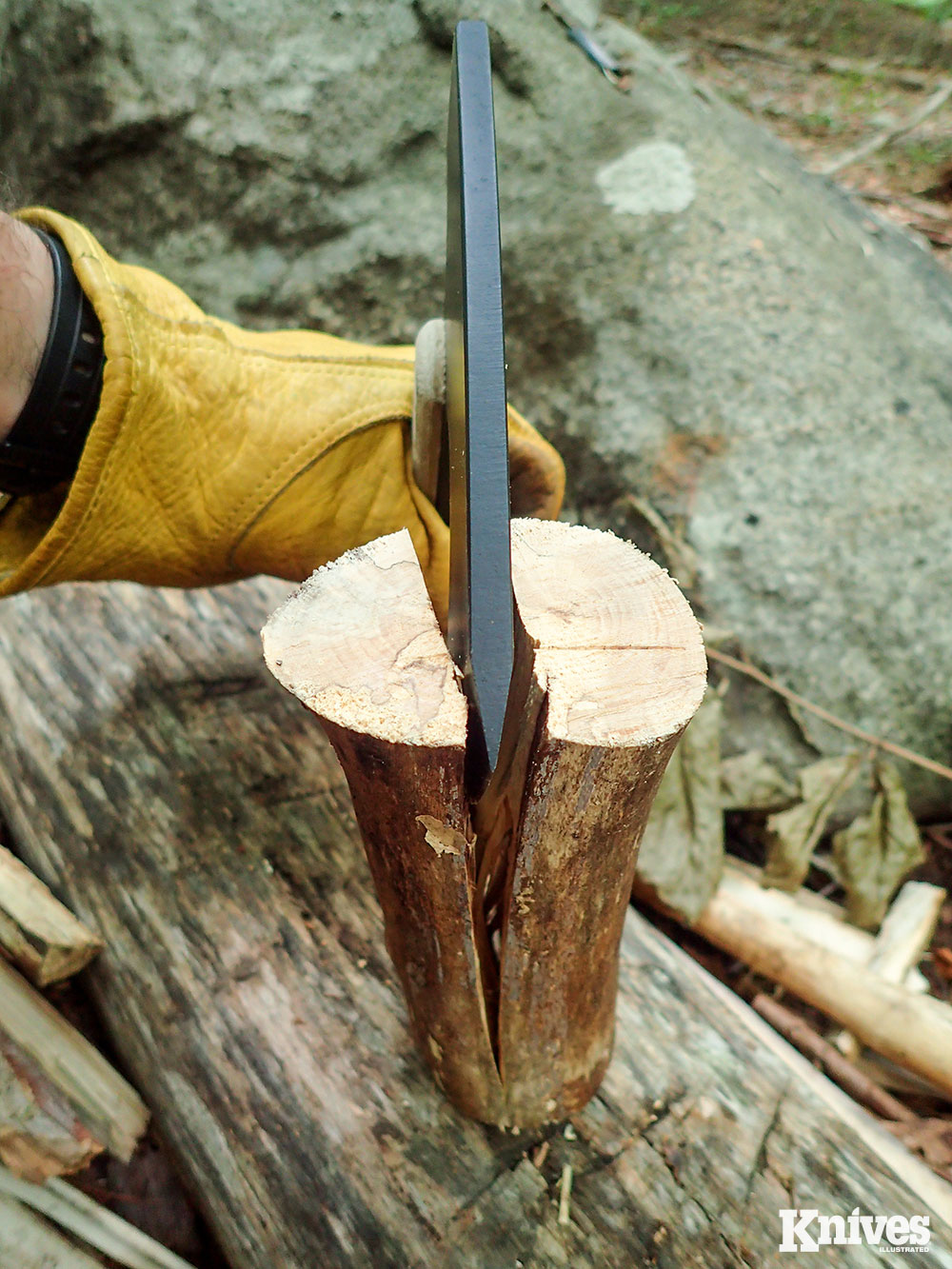
The Woodsman doesn’t have an eye that wedges like traditional tomahawks or hatchets, but once the sharp bit penetrates the wood it turns into ¼-inch abruptly. This aids in the splitting nature of the Woodsman.
Tomahawks and hatchets help with fire preparation by chopping and splitting wood. I used the bucksaw to cut poplar and maple for my Uberleben wood stove and campfires.
Having an axe, hatchet or the 15-inch handle version of the Woodsman Tomahawk in the winter is ideal; in the summer and fall, however, a smaller tool like the 12-inch handle Woodsman Tomahawk works fine.
Splitting wrist- to bicep-thick pieces of wood was definitely all I needed for fuel. I used a few different methods to split with the Woodsman. My least favorite way to split smaller diameter wood is by placing the sawed pieces on a stable wood backing and then chopping into the top, relying on accuracy and the wedging of the tool to complete the split.
I split the wider pieces that way—it’s more conventional. I reverted to using a baton to split smaller diameter wood, which is safer, more controlled, and accurate. For longer pieces of wood, regardless of their thickness, I used contact splitting.
Parallel with the wood, I placed the blade (bit) on top of the far end of the wood, lifted both together, and brought them down together on the stump, driving the bit into the wood, thus splitting it. This was repeated until I had thin pieces for kindling, some pieces of which I selected the straightest pieces to make into tinder.
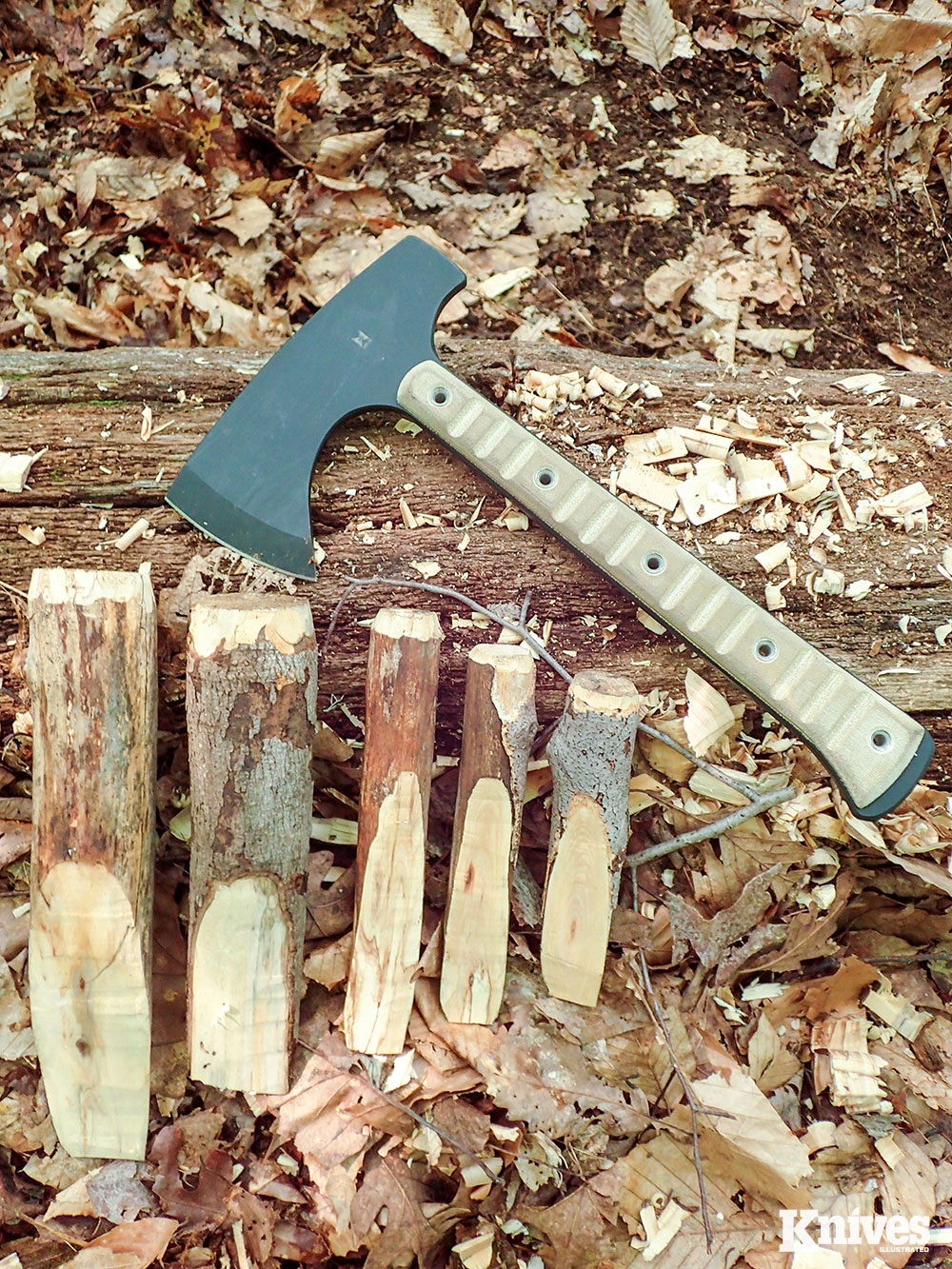
A set of wooden wedges is a must in a long term, semi-permanent camp. The Woodsman made these in a short amount of time.
Much like carving the wooden wedges, I dug the heel of the bit into the work stump and held it securely with one hand while the other hand drew the thin wood back against the sharpened edge. I made sure to slightly turn the stick taking advantage of the corners resulted in a thin, curly fuzz stick that would take a spark from a ferrocerium rod or small flame source.
The Woodsman Tomahawk proved to be a handy, tough, reliable woods companion in my summer camp.
EN GARDE
Too long for a big knife, too thick for a true machete, and too short for a real sword—so the Bush Sword is born.
Carrying the sheath cross-shoulder and drawing it made me feel as if I was about to duel. In this case, it was to duel some very thick, overgrowth completely covering the trail. There was barely enough room to swing the 15-inch plus blade as the entanglement of seep willow, stinging nettle, and blackberry vines blocked the path.
A few steps back and some well-placed low swings seemed to do the trick as the whippy front portion of the blade was the sweet spot for this type of springy, thin vegetation. It was a bit of a workout for the 3/16-inch blade as it wasn’t exactly a machete; however, it did the job.
“Part sword and part machete, the Helm Bush Sword will ensure you are ready for anything the wilderness throws at you.”
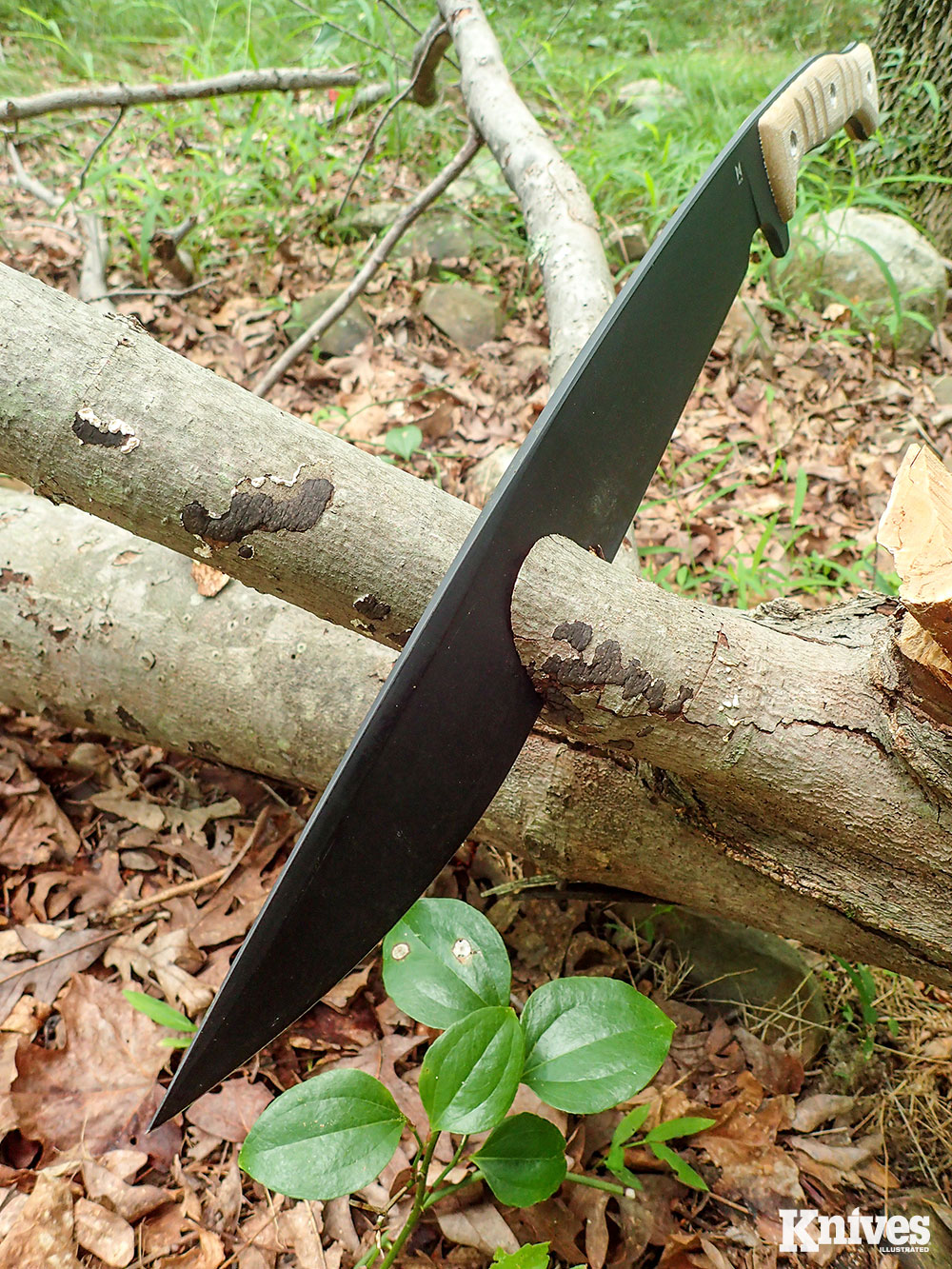
Deep penetration from the thin edge of the Bush Sword seen here. The blade is 3/16-inch thick, yet has a constant taper towards the tip.
The Bush Sword is a chopper, plain and simple. I don’t doubt for a minute that the Bush Sword could perform many aspects of camp chores and wilderness survival. However, this was a chopper—so chop I did.
I stuck with chopping wrist-thick, upward to calf thick wood since realistically that is what people would be processing in camp, making fire reflectors, constructing shelters, or making pole beds.
In my woods, there is no shortage of downed wood. Hardwood and softer poplar are readily available and just need minimal processing, most of which can be done with a sturdy pair of leather work gloves and a coaxing tool. The coaxing tool being a sharp one that will chop wood, trim vegetation, slash vines, and split wood if need be.
I came across a maple that was blown over about a year ago and had some good dry wood that I wanted to harvest. Chopping with the Bush Sword felt comfortable and didn’t take much time to get through the calf-thick wood. Big chips flew with authority, which were the perfect size for a small wood stove if collected.
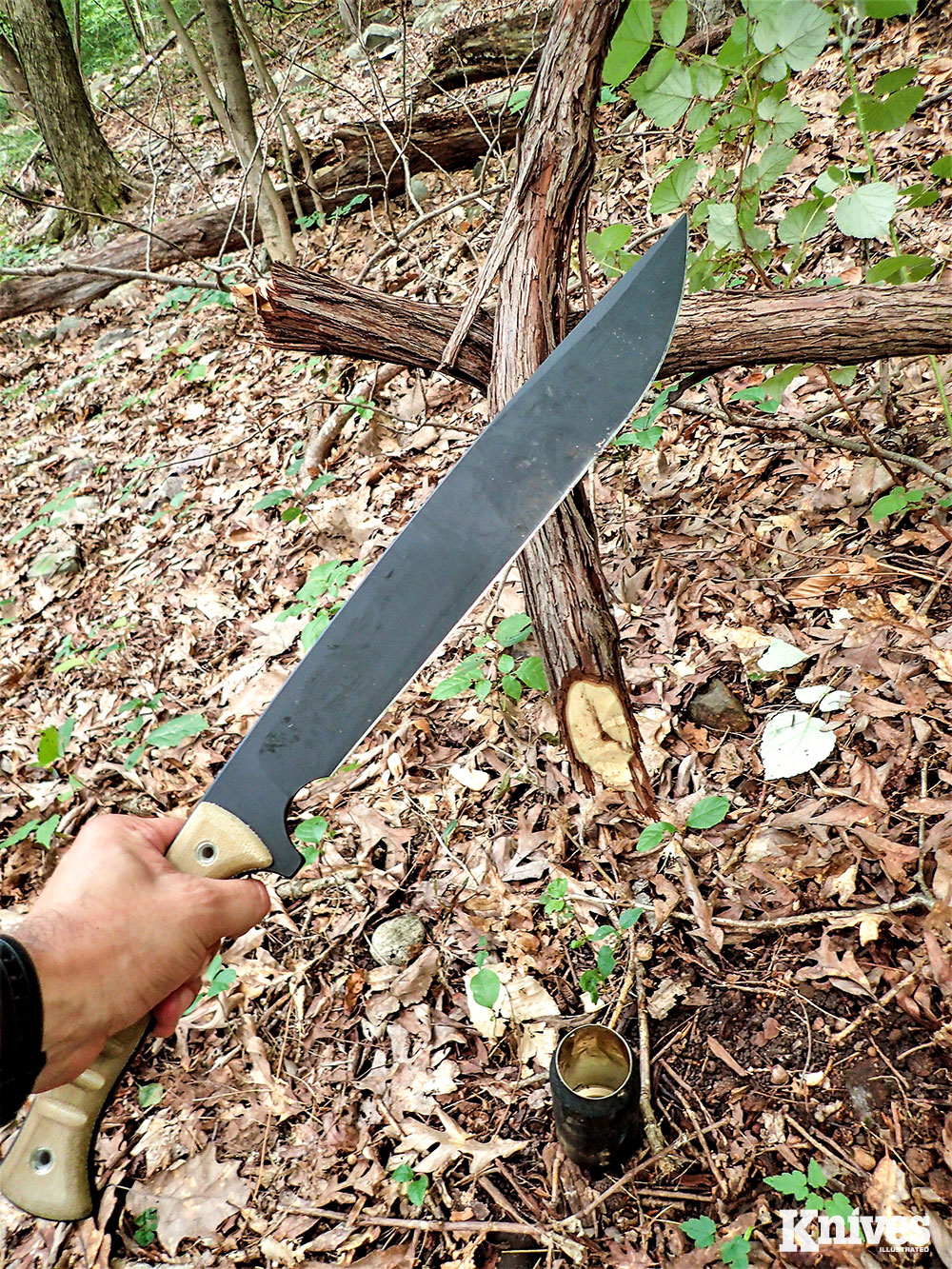
Water vines were cut with a few well-placed chops. These woody, yet springy vines have been known to drip water that could be collected for hydration.
When it came to limbing, broomstick-thick branches snapped off easily offering medium-sized fuel and craft parts. I came across a horizontal oak log that was raised off the ground and asking for a chopping. This was hardwood, so it was an arduous affair.
Chopping wood this hard is not without some effects on the hand. The grippy TeroTuf scales do just that—grip. It’s just part of the game; grippy textures will give some soreness. I wasn’t wearing gloves this time, so that could have been a factor.
Hard oak will make anything you strike it with vibrate, period! I came across freshly downed trees that still had supple, green branches that would be useful for trap parts and camp camouflage. Thin, finger to broomstick-thick pieces of beech and witch hazel sheared off easily with the Bush Sword.
Strangler vines that cover much of the forest in my area can be a good water source. I picked a few out that were creeping around healthy trees in an attempt to wrap themselves around and strangle them to death, and slashed a few to collect water and save a tree if possible. The woody, thick vines didn’t stand a chance against the Bush Sword.
Part sword and part machete, the Helm Bush Sword will ensure you are ready for anything the wilderness throws at you. It slashed with authority, taming this part of green hell.
HIGHLY RECOMMENDED
These so-called mid-tech knives are every bit as well made as the forged blades James makes, they’re just made by a different method. I highly recommend Helm Enterprises for a cutting tool, especially the Woodsman Tomahawk and Bush Sword. However, if you’re feeling primal, go for the carcass splitter.
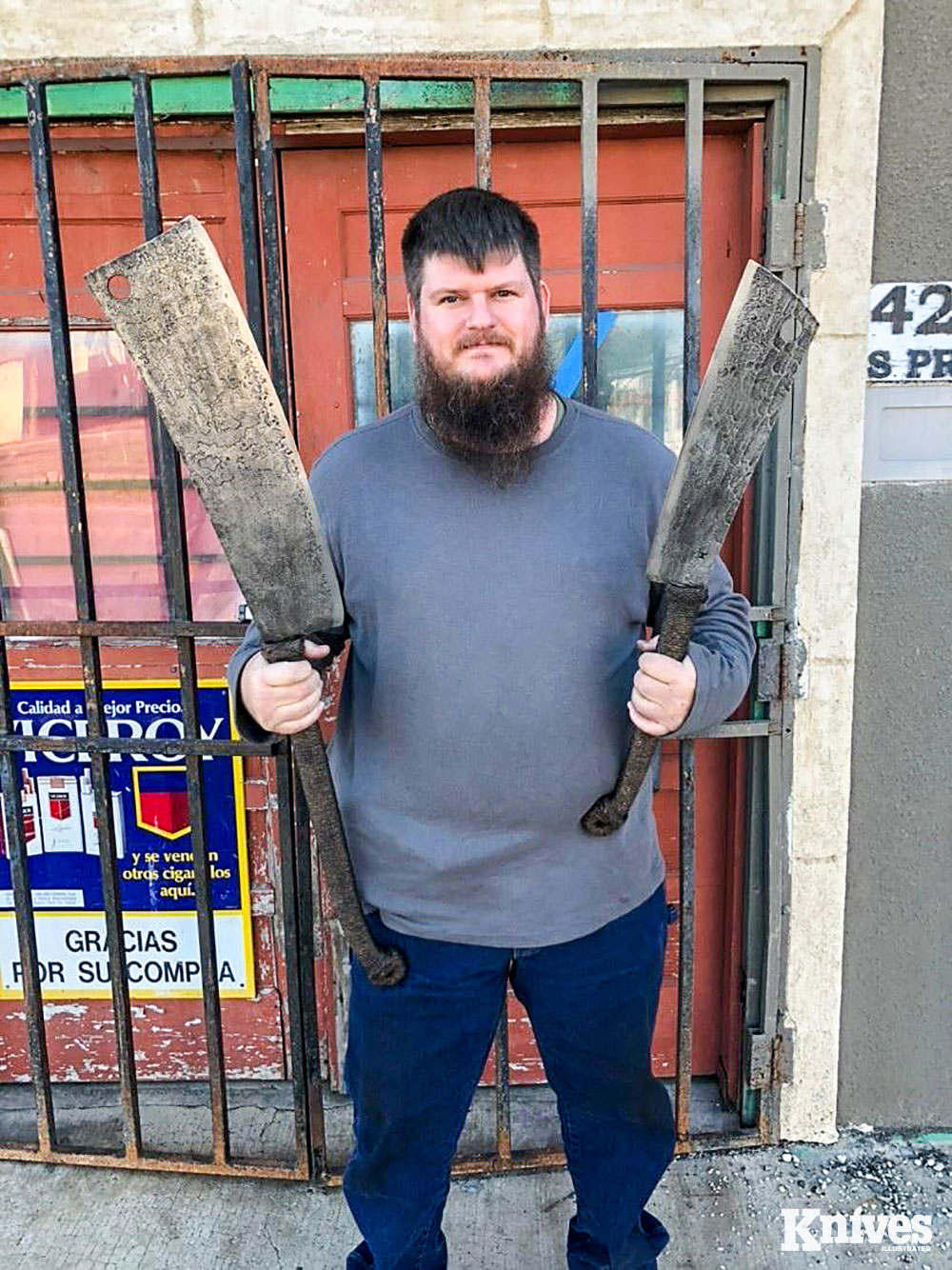
The carcass splitters from Helm Forge. These two massive blades are used to split carcasses and used by butchers and hunters. I have only held the smaller of the pair which was plenty big enough.
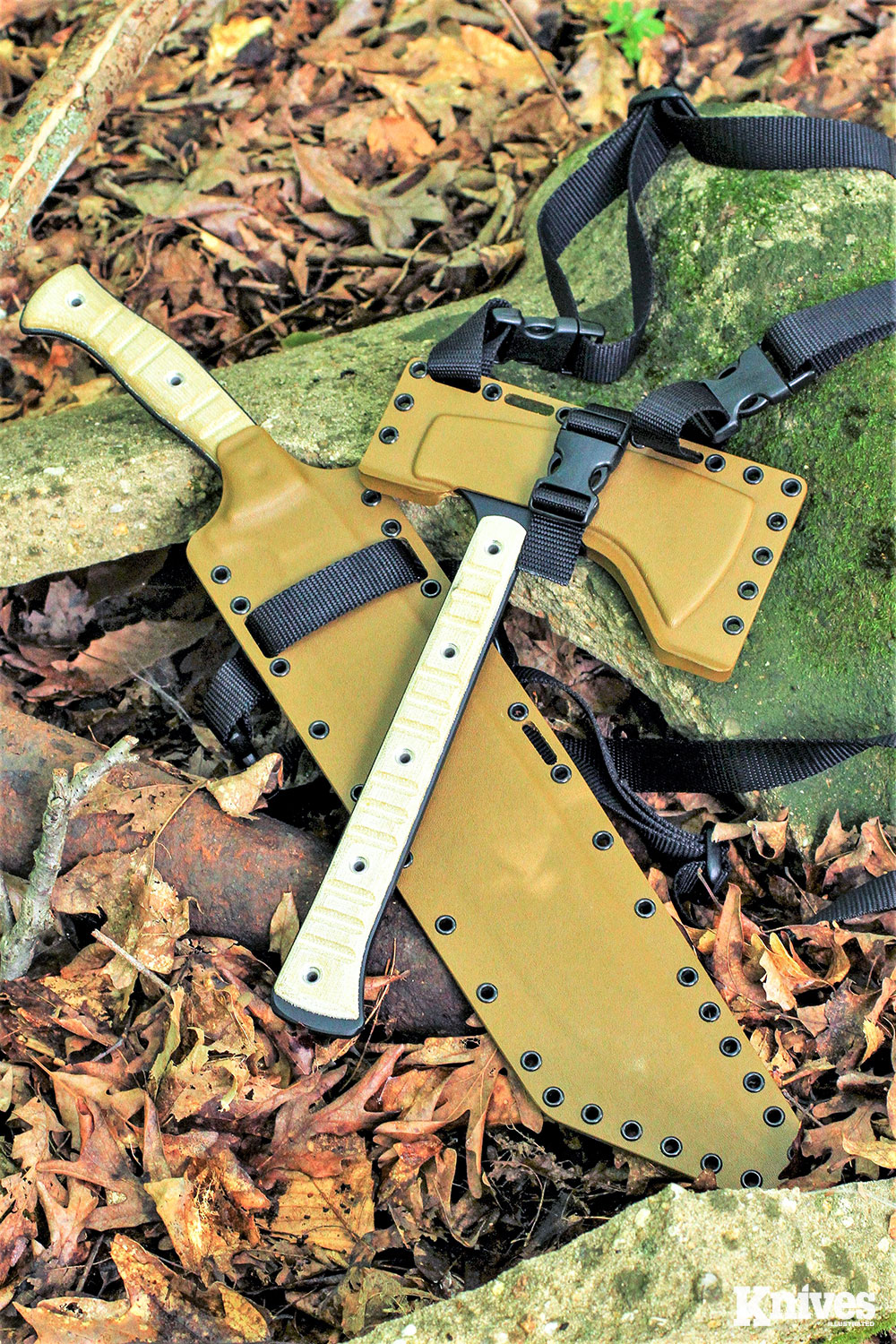
Both sheaths are made of Boltaron and are like standard chassis to which a variety of hardware and gear can be attached. James can add the shoulder straps for an additional charge.
ABOUT JAMES HELM
James Helm became interested in blacksmithing around age 15, researching the subject in books from the public library and on internet discussion forums. At age 16 he got a rivet forge, a small amount of coal and started pounding iron.
James had the opportunity to work for three metal artist shops in Texas and put together a small gas forge. He started producing knives to sell on his off-hours, working in his employers’ shops and moving his forge as out of the way as possible when finished. Finally, the chance came to rent his own workspace and start his business.
Whenever James’ father was contemplating some undertaking, whether custom hay baling or trucking, it was always under the name Helm Enterprises. As a nod to his father and his incalculable influence on his life, James named his business Helm Enterprises, Forging Division.
James is one of the “Forged in Fire” champions from Season 4, Episode 3.
SPECS
WOODSMAN TOMAHAWK
- Overall Length: 12 ½ inches
- Blade Length: 3 inches
- Thickness: ¼-inch
- Steel: 80CrV2 steel
- Finish: Cerakote
- Handle Scales: TeroTuf Coyote Tan
- Sheath: Boltaron
- Weight: 28 ounces
- Origin: USA
- MSRP: $300 (add $15 for sling)
SPECS
BUSH SWORD
- Overall Length: 22 inches
- Blade Length: 15 1/8 inches
- Thickness: 3/16 inch
- Steel: 80CrV2 steel
- Finish: Cerakote
- Handle Scales: TeroTuf
- Sheath: Boltaron
- Weight: 25.3 ounces
- Origin: USA
- MSRP: $650 (add $15 for sling)
SOURCE
Helm Enterprises
James Helm
HelmForge.com
helmgrind@gmail.com
210-209-1549

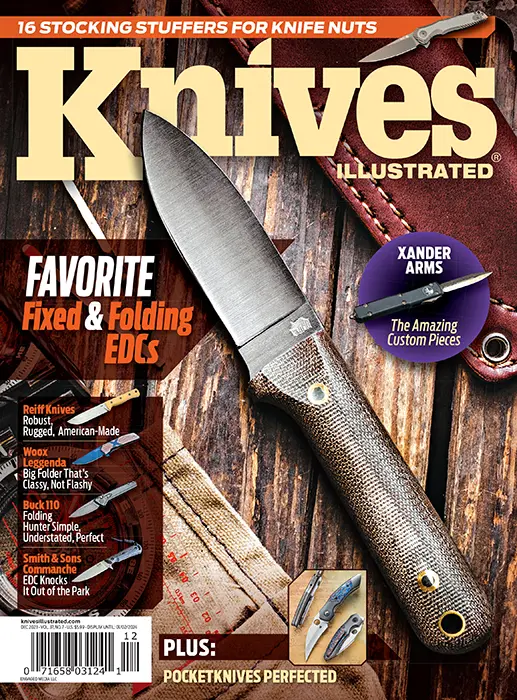 Subscribe / Back Issues
Subscribe / Back Issues